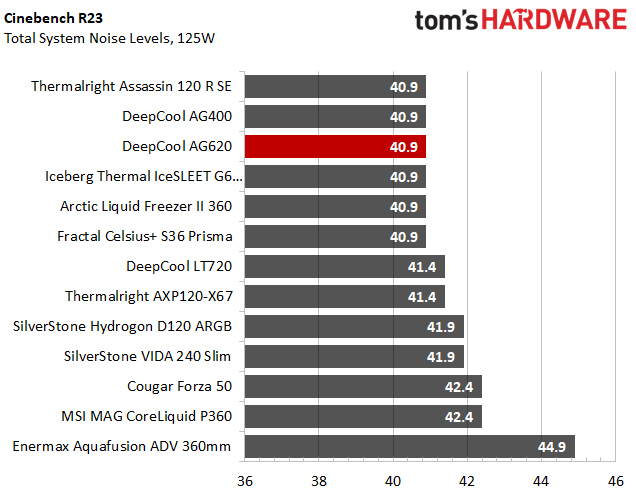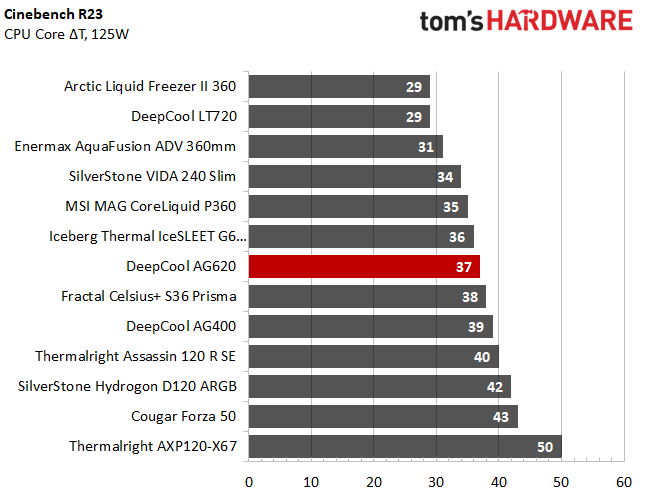Why you can trust Tom's Hardware
No Power Limits Cinebench Results
With Raptor Lake’s i9-13900K pushing speeds of 5.5 GHz or more, even the strongest of coolers hit TJ max while running Cinebench R23 and other demanding scenarios. As the 13900K is designed to aim for its top safe temperature, we’ll be comparing the overall benchmark score and the CPU’s clock speeds instead.
The results below are for a 10-minute testing run. But to be sure that was sufficiently long to tax the cooler, we also retested both Thermalright’s Assassin X 120 R SE and DeepCool’s LT720 with a 30-minute Cinebench test. The results didn’t change much at all with the longer test. The average clock speeds maintained dropped by 29 MHz on DeepCool’s LT720 and 31 MHz on Thermalright’s Assassin X 120 R SE. Looking at this another way, that’s an incredibly small 0.6% difference in clock speeds maintained, a margin of error difference that tells us that the 10 minute tests are indeed long enough to properly test the coolers.
Because of the difficulty of cooling the i9-13900K in this workload, we feel the best way to compare coolers here is to record the average power consumption of the CPU. Looking at this by total watts cooled only, the AG620 has a cooling advantage of ~30-50W compared to lower-end air coolers. Liquid coolers can of course sustain higher amounts, but not by much. The middle of the pack AIOs cool an additional roughly 20W, and the best performing AIO here – also made by DeepCool – can only handle up to 38W more.
Of course, total cooling capacity isn’t the only consideration in a cooler - how loud it operates is also a significant aspect. As Cinebench R23’s multi-core benchmark will push coolers to their limits, it’s also a great test for recording the worst-case scenario of fan noise levels.
You might notice that our noise charts start at 36dB. This is the noise floor of our testing environment. This makes 36dB our baseline measure, as we’re unable to measure noise levels below this threshold. Keep in mind that noise measurements are logarithmic, meaning the differences between the noise levels of the coolers will more significant than these graphs would suggest.
The AG620 does well here, running quieter than the other air coolers we’ve tested on the i9-13900K, with the exception of Thermalright’s SFF cooler, which has a much lower thermal capacity. It also runs quieter than all liquid coolers we’ve tested in this scenario, save for for Arctic’s Liquid Freezer II.
I would also note that, aside from dB ratings, at full fan speeds I found the noise produced by this cooler to be slightly annoying. The pitch of the fans is whiny compared to other units, which is something that can’t be captured by my noise meter.
Get Tom's Hardware's best news and in-depth reviews, straight to your inbox.
We’re also showing the total Cinebench R23 benchmark scores to show how little is lost – or gained – with different cooling solutions. Between the weakest and strongest coolers, we have a total benchmark score variance of roughly 13%.
DeepCool’s AG620 is the strongest air cooler we’ve tested thus far in this benchmark, scoring 38,849K points, which is between between 1,300 and 3, points higher than the lower-end air coolers in this test.
200W Cinebench Results
When restricting power consumption to a more reasonable 200W, the AG620 continues its lead over the lower-end air coolers, by up to 15 degrees Celsius, but falls up to 5 degrees C behind high end 360 mm AIOs.
The acoustic performance of the AG620 was middle of the road at 200W. It wasn't particularly loud, but it wasn’t the quietest result either.
125W Cinebench Results
The lowest power limit I test at is 125W, mainly because this is also the lowest level where I can reliably measure noise measurements. Lower power consumption causes the noise of many CPU coolers to fall below the noise created by the system fans (even while restricted to 35% speed).
When limited to 125W, the AG620 ran silently; the noise profile is essentially indistinguishable from the rest of the system fans. In terms of actual CPU temperature, it’s in the middle of the pack (compared to other units), but as this is a low noise performance scenario there’s no cause for concern.
Conclusion
DeepCool’s AG620 is a solid dual tower air cooler that pairs well with Intel’s Core i9-13900K, handling loads of up to 277W with a total cooling capacity just shy of high end AIOs. At only $54.99 USD, the AG620’s value is hard to beat. But if whining fans bother you, you may want to spend more on something else, or perhaps swap out the included fans for something else with a more pleasing sound signature.
- MORE: How to Buy the Right CPU Cooler
- MORE: How to Overclock a CPU
- MORE: How to Check CPU Temperature
- MORE: All CPU Cooling Content

Albert Thomas is a contributor for Tom’s Hardware, primarily covering CPU cooling reviews.
-
Exploding PSU I've been hearing great things about their AK620. This looks like a more affordable version of that cooler.Reply
Never used deepcool products before, but I think I might need to check them out. -
LokkenJP Hi.Reply
Any chance of putting this cooler in perspective with it's bigger brother the AK620? I'm interested in the difference in performance and acoustics between them. They seem to share the same basic design layout, but not sure if the fans are the same, and some internal compromises can go a long way for the relatively small price difference between them -
Justin A Reply
there is almost no difference between the performance of the AG620 and the AK620, the only differences between the two coolers being that the AG620 comes with ARGB fans that are slightly and by slightly i mean within a 1-2 percent margin worse than the AK620. in my opinion, this cooler is better due to the fact that i can pair the lighting with internal cpu temps to let me know if things are getting too hot. for the record, with the 13th Gen i7 and this cooler only (along with a Cooler Master Masterbox TD500 Mesh case and it's stock fans) the temps have only gone above 85 degrees during a stress test. I could overclock with just this air cooler.LokkenJP said:Hi.
Any chance of putting this cooler in perspective with it's bigger brother the AK620? I'm interested in the difference in performance and acoustics between them. They seem to share the same basic design layout, but not sure if the fans are the same, and some internal compromises can go a long way for the relatively small price difference between them
Exploding PSU said:I've been hearing great things about their AK620. This looks like a more affordable version of that cooler.
Never used deepcool products before, but I think I might need to check them out.
it's about the same price as they are nearly identical. the zero dark thirty version of the ak620 is 10 bucks more.
highly recommend deepcool air coolers! the ag/ak620 and the assassin 3 are some of the best air coolers one can buy *(regardless of cost). some reviewers even put the ak620 above the noctua nh-d15. -
Albert.Thomas ReplyLokkenJP said:Hi.
Any chance of putting this cooler in perspective with it's bigger brother the AK620? I'm interested in the difference in performance and acoustics between them. They seem to share the same basic design layout, but not sure if the fans are the same, and some internal compromises can go a long way for the relatively small price difference between them
There's very few differences between the AG620 and the AK620. The main difference is between the two is the plastic top on the AK model. Other than that, the fans are slightly different speeds but the heatsink is basically identical. -
docboy Anyone use the AG620 for their 13900k build? Has it been able to keep temperatures <100c assuming one adjusts Bios to limit the cpu to 253W?Reply






